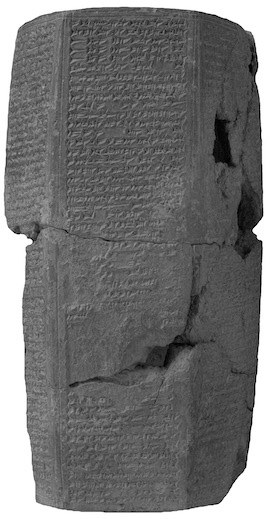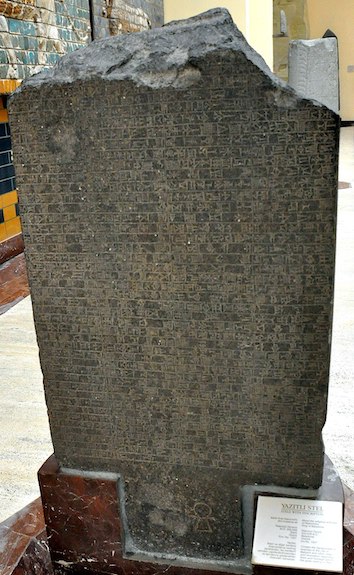Edara'ana (cella of Zarpanītu in Esagil at Babylon)

Edara'ana is the cella of the goddess Zarpanitu (the consort of Marduk) in the main building of Esagil. Its main gate was Kahilisu and its dais was Ehalanki. The Neo-Assyrian king Ashurbanipal (r. 668–ca. 631 BC) and the Neo-Babylonian rulers Nebuchadnezzar II (r. 604–562 BC) and Nabonidus (r. 555–539 BC) worked on this important goddess' cult room(s), which was situated in the as-of-yet-unexcavated northwest corner of the building. Those rulers refer to Zarpanitu's holiest room in their royal inscriptions as Ehalanki or Kahilisu, rather than as Edara'ana. This section of Esagil was accessed via Ka-Lamma-arabi (the northern gate of the main temple; = Gate D), which also went by the name Gate of Bēltīya.

BM 121006+, a six-column clay prism that is inscribed with the so-called "Prism T[hompson] Inscription" of Ashurbanipal. The placement of a bed in Kahilisu is recorded at the very end of col. i. © Trustees of the British Museum.
Names and Spellings
A list of gates of Esagil and the so-called "Canonical Temple List" respectively refer to Edara'ana as the cella (Akkadian papāhu) and temple (Akkadian bītu) of Zarpanitu. This Sumerian ceremonial name means "House of the Ibex of the Heavens." According to Tablet II of the five-tablet scholarly compendium Tintir = Babylon, Ehalanki was the seat (Akkadian šubtu) of Zarpanitu; a fragmentary Akkadian inscription of Ashurbanipal, Assyria's last great king, calls it "the luxuriant seat" of the goddess Ninbaragesi (a name of Zarpanitu dating back to the Old Babylonian Period). The so-called "Götteradressbuch von Assur" (Divine Directory of Ashur), translates the Sumerian ceremonial name as Akkadian bīt pirišti šamê u erṣetim, which means "House of the Secrets of the Heavens and Netherworld." An Akkadian inscription of Nabonidus, the last native king of Babylon, regards Ehalanki as a multi-room complex, rather than the seat within Edara'ana, and refers to it as the "room of secret(s) of the god Marduk and the goddess Zapanitu" (Akkadian bīt pirišti marduk u zarpanitu). According to two lists of Esagil's gates, Kahilisu was the gate of Zapanitu's cella; one copy of Ludlul Tablet IV gives it the name Kahiligar. In royal inscriptions of Ashurbanipal and Nechchadnezzar II, the second king of the Neo-Babylonian Empire, Kahilisu — whose Sumerian ceremonial name means "Gate Sprinkled with Luxuriance" — Is regarded as Zarpanitu's bed chamber, cella or seat, rather than as the gate of her cella. The name is interpreted in those texts as the "gate of sexual charm" (Akkadian bāb kuzbu), "the gate adorned with sexual charm" (Akkadian bāb kuzbu zânu), and the "the bed chamber of the goddess Zarpanitu, which is laden with sexual charm" Akkadian maštak zarpanitu ša kuzbu salhu).
- Written Forms: e₂-dara₃-an-na; e₂-hal-an-ki; ka₂-hi-li-gar; ka₂-hi-li-su₃.
Known Builders
- Neo-Assyrian (ca. 911–612 BC)
- Ashurbanipal (r. 668–ca. 631 BC)
- Neo-Babylonian (ca. 625–539 BC)
- Nebuchadnezzar II (r. 604–562 BC)
- Nabonidus (r. 555–539 BC)
Building History
In 656 BC, or at the very beginning of 655 BC at the latest, the Assyrian king Ashurbanipal was made aware of the fact that several objects of the god Marduk and his consort Zarpanitu that had been taken to Assyria by his grandfather Sennacherib (r. 704–681 BC) in 689 BC were still in the city of Ashur (modern Qalat Sherqat). Sennacherib had given Babylon's tutelary deity's bed (Akkadian eršu) to the Assyrian national god Aššur. When Ashurbanipal learned of this appropriation, he reclaimed the bed for Marduk (and Zarpanitu) and had it refurbished. The bed, together with other important objects, entered Esagil in early 655 BC and was placed in Kahilisu. Although Ashurbanipal is not known to have sponsored construction on Edara'ana (or any part of it), he might have finished its rebuilding since he regularly claims to have completed the work of his father Esarhaddon (r. 680–669 BC), including the renovation of Esagil's platforms and daises, which he had rebuilt according to their former specifications. This likely included Ehalanki, Zarpanitu's dais.

The lower half of a basalt stele (Ist EŞEM 01327) that is inscribed with a long Akkadian inscription of the Neo-Babylonian king Nabonidus. The so-called "Babylon Stele" records that ruler's work on Esagil, including providing Ehalanki with new doors. Image reproduced via Creative Commons Attribution-Share Alike 4.0 (CC BY-SA 4.0) license via Wikiwand.
Several Akkadian inscriptions of the Neo-Babylonian king Nebuchadnezzar II, including one written on a large stone tablet (the so-called "East India House Inscription") and a few written on rock faces in Lebanon, record that this ruler lavishly decorated Kahilisu, which he sometimes refers to as the cella of Zarpanītu, with a gold alloy, making it shine like daylight.
An Akkadian inscription of the Neo-Babylonian king Nabonidus written on a broken basalt stele records that he renovated and refurbished some of the principal gateways of Esagil, including Ehalanki (which is mentioned as Zarpanitu's main cult room rather than Edara'ana), principally by providing them with new wooden doors. The entrance to Zarpanitu's cella was among them. The relevant passage of the so-called "Babylon Stele" reads:
Archaeological Remains
The rooms in Esagil associated with Zarpanitu are located in the northwestern corner of the main part of Esagil, southwest of Ka-Lamma-arabi (= Gate D), northwest of the Court of Bēl (the central courtyard of the main part of Esagil), and north of Eumuša (the cella of the god Marduk). Because this part of Babylon's principal temple is still largely unexcavated, Edara'ana, Ehalanki, and Kahilisu have not yet been positively identified in the archaeological record.
Based on a metrological text referred to as the "Bricks of Esagil," it is likely that Edara'ana was situated on the western side of a courtyard (the Court of Bēltīya) whose northern wall was the southern side of the northern exterior wall of Esagil. Like Marduk's cella Emuša, Edara'ana was entered from its eastern side, via its gate Kahilisu. Given the lack of archaeological evidence, it cannot be proven with absolute certainty.
Further Reading
- Da Riva, R. 2021. "In and around the Court of Bēl and the Cultic Topography of the Esagil according to Late Babylonian Ritual Texts," in U. Gabbay and S. Gordin (eds.), Individuals and Institutions in the Ancient Near East: A Tribute to Ran Zadok (Studies in Ancient Near Eastern Records 27), Boston and Berlin, pp. 191–192 and 200–201.
- George, A.R. 1992. Babylonian Topographical Texts (Orientalia Lovaniensia Analecta 40), Leuven, pp. 88–91, 270–271, 393–395 and 402–403.
- George, A.R. 1993. House Most High. The Temples of Ancient Mesopotamia (Mesopotamian Civilizations 5), Winona Lake, p. 74 no. 145, p. 98 no. 448, and p. 107 no. 555.
- George, A.R. 1995. "The bricks of E-sagil," Iraq 57, pp. 173–197.
Banner image: areal photograph of the excavation pits and trenches in the area of the remains of Esagil and Etemenanki taken in 1923 (left); a reconstruction of Esagil and Etemenanki during the reign of the Neo-Babylonian king Nebuchadnezzar II (center); a plan of Esagil, and Etemenanki (right). Images from O. Pedersén, Babylon: The Great City, pp. 144–145 figs. 4.3–4.4 and p. 151 fig. 4.11.
Jamie Novotny
Jamie Novotny, 'Edara'ana (cella of Zarpanītu in Esagil at Babylon)', Babylonian Temples and Monumental Architecture online (BTMAo), The BTMAo Project, a sub-project of MOCCI, [http://oracc.org/btmao/Babylon/TemplesandZiggurat/Esagil/RoomsandGates/Edara'ana/]